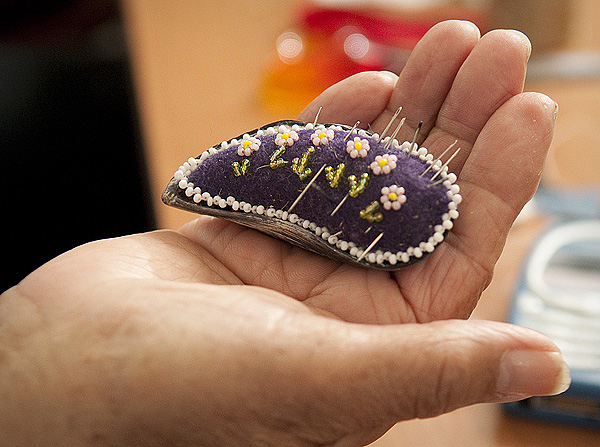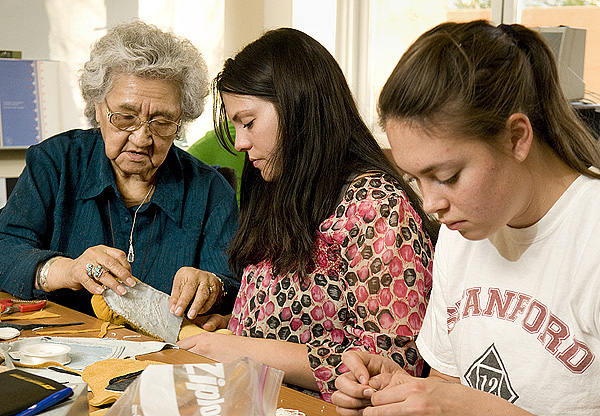Cultural center helps Native American students find a home at Stanford
The Native American Cultural Center helps American Indian students thrive academically, culturally and socially by providing a sense of community.
Samantha "Sam" Azure grew up on the Fort Peck Indian Reservation in Montana. Most of her high school classmates didn't go to college, but her parents pushed her and her brothers to take advantage of opportunities they never had. During her last year of high school she looked at local state colleges and a few top-notch universities, including Stanford.
Azure first visited Stanford in 2005 during Admit Weekend – when the most recent class of admitted students come to campus. It was her first time venturing out alone from Montana and she described the visit as a whirlwind experience. "On my last day of Admit Weekend, I was tired of California and wanted to go home," Azure said. "Then I found the Native Center and I was so happy, I was in tears. It changed my entire view of Stanford."
The assistant director of the Native American Cultural Center, Denni Woodward (Mescalero Apache), greeted her and introduced her to another student from Montana. The center, located in the Old Union, serves as a home away from home for students. The staff ensures that students are taken care of academically, socially, culturally and mentally. Students use the center's large kitchen and lounge to hold potlucks, film festivals and meetings for the Stanford American Indian Organization.
The center has its own tutors, who later helped Azure learn study skills she never acquired on her reservation. The center's library houses thousands of American Indian books, which proved invaluable to Azure, who in 2009 earned dual bachelor's degrees in American studies and Native American studies.
Azure ultimately chose Stanford because the financial aid package, cultural center and already thriving American Indian community were too good to pass up. "I felt good knowing that I had a community waiting there for me, that would support me throughout my years at Stanford, not only academically but culturally as well."

Alaskan native Mabel Pike holds a shell with a beaded pincushion she made as she taught students at the Native American center. Students cut, stitched and beaded traditional moccasins in the course of a week.
Community plays a major role in bringing students to Stanford. Nationally, American Indians make up only 1 percent of the undergraduate student body, up from 0.7 percent in 1976. Stanford stands at 3 percent.
"The Native Center, all the support systems and the critical mass of students really draws more people in to Stanford," said Cherokee alumna Adrienne Keene, '07. "The numbers keep going up because the word is getting out."
What's more, American Indian students at Stanford stick out the four-year duration to graduate. Nationally, for NCAA Division 1 schools, American Indians have the highest dropout rates, with only 36 percent graduating. At Stanford, roughly 90 percent of American Indian students graduate, nearly consistent with the 92 percent graduation rate of the entire student body.
To welcome students to campus and ease their transition, Stanford provides the Summer Native Immersion Program (SNIP) prior to the fall New Student Orientation. During SNIP, students are connected to liaisons in the financial aid and registrar's offices, and the writing, advising and research programs – in addition to the Native Center. Azure immediately felt she had a community and a set of people she could go to if she had problems adjusting to college life.
When American Indian students arrive for their first quarter, the local Muwekma Ohlone Tribe provides a home-cooked meal. "They welcome the new students to this land," Woodward said. "When the local tribe comes and greets everyone, it really helps show that there is a supportive community beyond Stanford."
Ten years ago, Stanford began sending American Indian recruiters to states with large American Indian populations and to reservations. Among the things recruiters highlight is the powwow.
Stanford has the largest student-run powwow in the nation. "It's a big to-do and the students get really excited about it," said Woodward. "The powwow is really what gives Stanford a name in Indian country."
The American Indian community house, called Muwekma-Tah-Ruk – meaning "house of the people" in the Muwkma-Ohlone language – also provides another space for students on campus. Resembling other ethnic theme houses on campus, half of the residents are American Indian, while the other half are students interested in learning more about Native cultures.
The financial aid program established in 2008 should boost the number of Native students further. If a family makes less than $60,000 a year, students don't have to pay for tuition and room and board at Stanford. "For low-income and minority families, that's huge," Keene said. "Already, application numbers went up considerably from last year."
Last year, as she prepared to graduate, Azure reflected on her Stanford experience warmheartedly. "Only after a few quarters at Stanford, I began to realize that there was not another university out there that I could have been more happy at or been as successful at," she said. "The strength of our Native community here at Stanford is our ability to come together as a community."


Share This Story